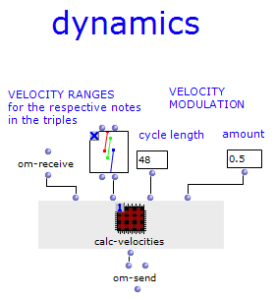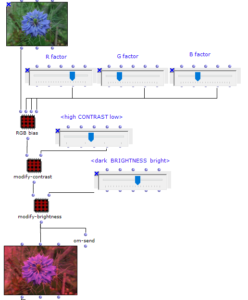Interspaces juxtaposes sounds from human civilization with sounds from nature. Four pairs of field recordings are presented, which are filtered according to the principle of a vocoder according to the spectrum of a section of the counterpart.
Responsible: Florian Simon
Interspaces shows the following four pairs (format: total recording – source of the spectrum):
-
Chirping Arctic terns – Vowel “E” called by humans
Lively market, people talking and calling – Arctic tern call -
Rippling of a river – Accelerating car
Main road – rushing of a river -
Forest scenery, rustling leaves and birds – Train horn
Station concourse – chirping of a songbird -
Thunderstorm – clinking of cutlery
Business in a restaurant kitchen – thunder
The field recordings come from the FreeToUseSounds library.
Interspaces uses an equilateral octagonal loudspeaker arrangement, whereby the two channels of the source material are each placed at opposite points in the array. The two recordings of a pair are also offset by 90 degrees from each other by default, so that four sound sources can be perceived.

Each recording is divided into several sections of random size within a certain frame and concatenated again in randomized order with short crossfades. The number of sections increases with each pair of recordings: 4, 9, 16 and finally 23. With each new section, the two sound sources also “move” in the array by 0.25 channels in a certain direction. Since the number of sections is the same for both recordings of a pair, but not the position of the cuts, deviations from the base of a 90-degree spacing and a greater variety of sounds are created. Interspaces is designed as an installation to allow free exploration of the stereo fields.
Interspaces was created in OpenMusic using functions from the OM-SoX library. The underlying program consists of two parts. The first is used to create the manipulated recordings by spectral analysis (sox-dft), splitting the source material into up to 4096 frequency bands (sox-sinc), adjusting their volume levels according to the generated spectrum (sox-level) and reassembling them (sox-mix).


The second part of the program uses the synthesis patch of a maquette to control the division into sections (sox-trim) and their spatialization (sox-remix) and final alignment (sox-splice) for each of the eight generated audio files, and finally to organize the finished blocks in terms of time (sox-pad and sox-mix). In the last step, the time saved by the crossfades must be taken into account and subtracted from the onset value/x position in the maquette.

Audio (binaural mixed to stereo):
Unfortunately, this vocoder method has the disadvantage that the individual frequency bands are initially very quiet and therefore artefacts in the form of noise occur when applying the gain and the final normalization. Conversely, clipping occurs when certain frequencies are strongly represented in both source recordings. If you lower the gain values accordingly to avoid this, quieter sections in the result may be barely audible, depending on the size of the dynamic difference. The noise can be easily eliminated by selecting higher gain values, but this increases the clipping problem. In the above version of Interspaces, the best compromise between the two effects was sought for all eight audio clips.




